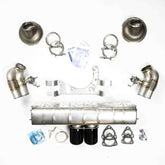I have a CEL (check engine light or service engine light). What should I do?
Without knowing the specific fault code, it is nearly impossible to assist.
Start here: https://youtu.be/gaOdgACaV3Q.
Every enthusiast should own an OBDII Scan Tool! Here’s a link to an affordable Scan Tool we’ve used with great success.
When troubleshooting a fault code, it’s easy to jump to conclusions, but it’s important to be methodical. Start with the fault code, and go from there. Below is a list of common codes we see and the potential causes. This is not a sure-fire answer, but it’s usually a good place to start.
Common CEL’s and causes we have seen:
P014A, P015B – the powertrain control module (PCM) has detected a delayed response time from the downstream (or post catalytic converter) oxygen (O2) sensor or circuit for engine bank two (015B is for the upstream or pre-cat O2 sensor).
Typically, loose V-bands can create an air leak and cause the fault code. Double-check that the gaskets are in place and the v-bands are tight. Do NOT use anti-seize on the v-band bolts as they can loosen.
P2279 – the engine control module (ECM) detecting a vacuum leak into the engine. This means that unmetered air is entering the engine without the engine sensing it going through the mass air flow sensor and throttle body.
Typically, it’s an installation issue. The system needs to check for vacuum leaks using a smoke machine. Also ensure the vacuum lines and solenoids are plugged in appropriately and not pinched.
P2101 - the engine control module (ECM) detecting the throttle actuator control (TAC) went out of the range of the circuit causing an open circuit to be detected in the TAC motor.
This is an error related to the electronics inside the throttle body. Please contact the Dundon Sales team for a replacement.






